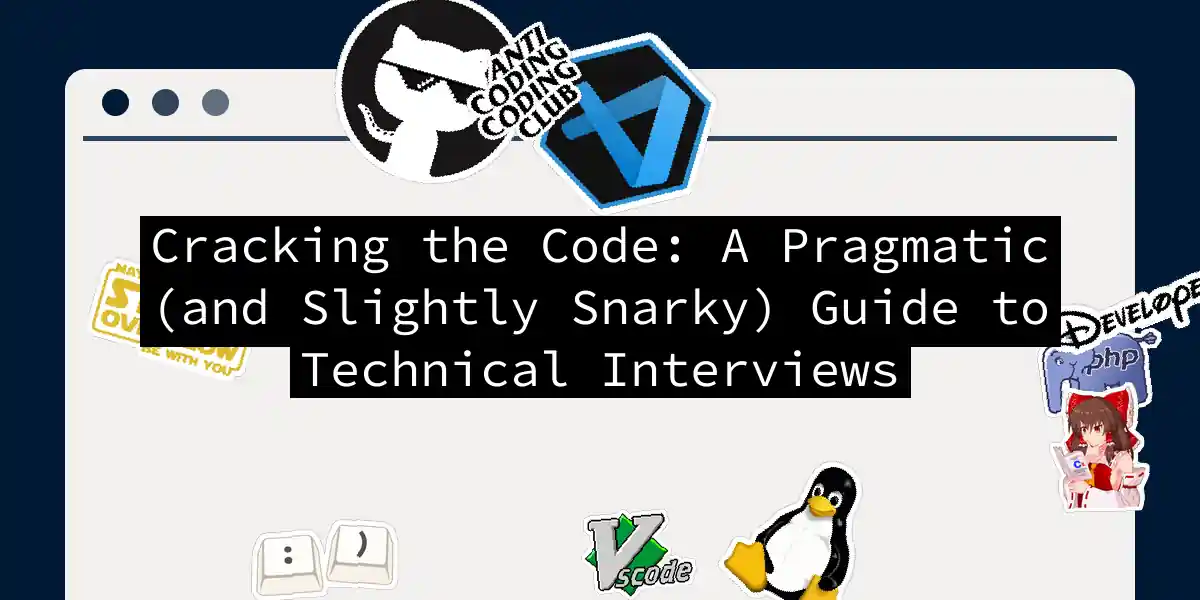Let’s face it - technical interviews are like first dates. You prepare excessively, worry about saying something stupid, and 50% of the time walk out wondering if “O(log n)” was an appropriate response to “Where do you see yourself in 5 years?” Here’s how to navigate this ritual with your sanity intact.
The Coding Gauntlet: Surviving the Algorithm Colosseum
Step 1: Speak Before You Code
When presented with a problem like “Find the kth largest element,” don’t jump straight to typing. Narrate your thoughts like a sports commentator:
“I’m thinking we could sort the array first… but that would be O(n log n). Wait, maybe a max-heap? Oh right, but building the heap is O(n) and extracting k elements would be O(k log n). Or perhaps a quickselect approach for average O(n) time?”
This verbal diarrhea helps interviewers follow your logic and shows you’re not just pattern-matching from LeetCode.
Code Example: The Two-Sum Two-Step
# Beginner's approach - O(n²) time
def two_sum(nums, target):
for i in range(len(nums)):
for j in range(i+1, len(nums)):
if nums[i] + nums[j] == target:
return [i, j]
return []
# Optimized approach - O(n) time with hash map
def two_sum_optimized(nums, target):
num_map = {}
for i, num in enumerate(nums):
complement = target - num
if complement in num_map:
return [num_map[complement], i]
num_map[num] = i
return []
Pro tip: Always mention time/space complexity first - it’s like saying “I love your eyes” before asking someone out.
System Design: Building Castles in the Cloud (Without Getting Rained On)
When asked to design Twitter/URL shortener/Yet Another Chat App:
- Clarify requirements like a paranoid lawyer:
“Are we optimizing for read or write heavy traffic? What’s our SLA for tweet delivery? Do we need to support edit/delete functionality?” - Draw this diagram (they’ll pretend to understand it):
- Mention tradeoffs like they’re relationship red flags:
“We could use Cassandra for write scalability, but it’s terrible for range queries. Maybe a time-series database instead?”
Behavioral Questions: How to STAR Without Looking Like a Constellation
The STAR method (Situation, Task, Action, Result) works best when seasoned with specific metrics and a dash of humblebrag:
Bad answer:
“I fixed a bug in our API.”
Gold STAR answer:
“Situation: Our payment processing API was failing for 3% of users during peak hours. Task: I needed to reduce errors below 0.5% without impacting latency. Action: I implemented exponential backoff retries with circuit breaking using Netflix Hystrix. Result: Errors dropped to 0.2% and we saved $12K/month in failed transaction fees.”
Pro tip: Keep a “brag doc” of your achievements - it’s like a dating profile but for your career.
The Negotiation Tango: Getting Paid Without Getting Played
When they make an offer, respond with:
“That’s interesting. I was expecting something closer to [20% higher than their offer] based on my research on Levels.fyi and the value I can bring to [specific project].”
Use this comparison table as your secret weapon:
| Component | Lowball Offer | Realistic Range | Your Target |
|---|---|---|---|
| Base Salary | $120k | $135k-$150k | $145k |
| Signing Bonus | $10k | $20k-$30k | $25k |
| Stock Options | 50 RSUs | 80-120 RSUs | 100 RSUs |
Remember: The first person to name a number loses. Unless you’re playing financial chicken with Jeff Bezos.
Technical interviews are equal parts knowledge, performance art, and psychological warfare. But with these strategies, you’ll be ready to turn “How would you sort a linked list?” into “When can you start?” Just don’t forget to wear pants - even for Zoom interviews.
